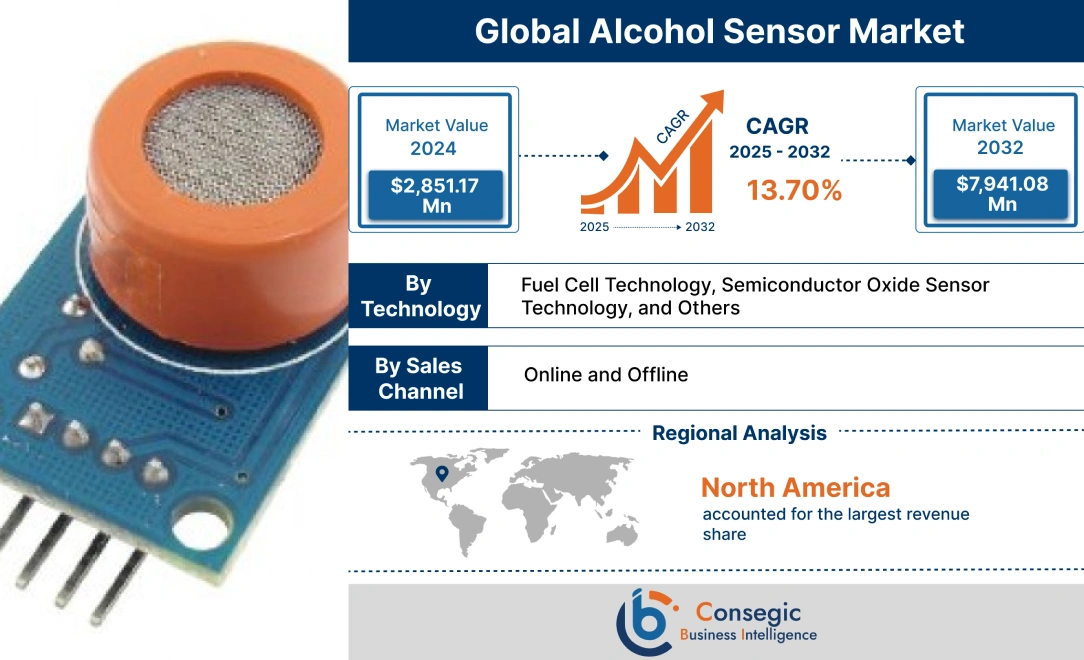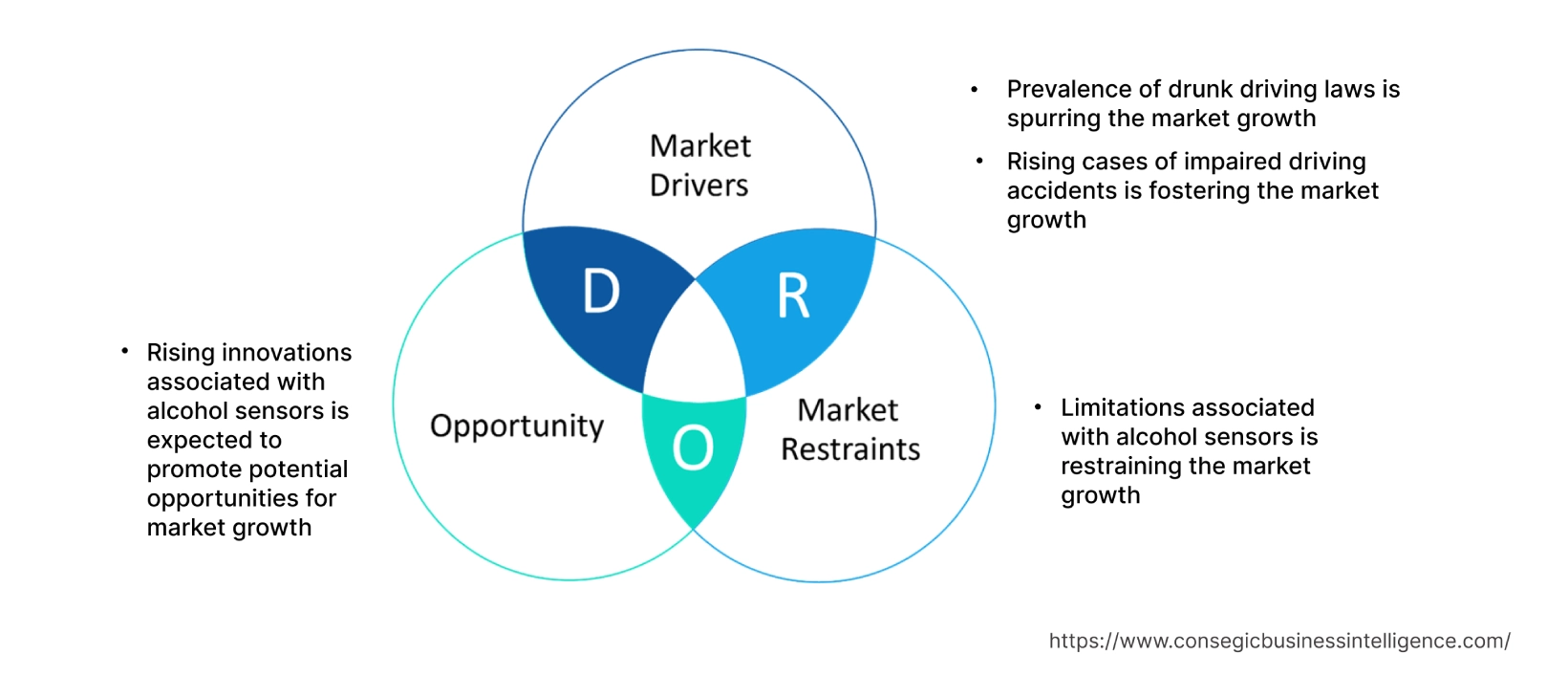- Summary
- Table Of Content
- Methodology
Alcohol Sensor Market Introduction :
Alcohol Sensor Market size is estimated to reach over USD 7,941.08 Million by 2032 from a value of USD 2,851.17 Million in 2024, growing at a CAGR of 13.70% from 2025 to 2032.
Alcohol Sensor Market Definition & Overview :
Alcohol sensors refer to devices that are designed for analyzing samples of breath for measuring the concentration of ethanol in a person's system, which are further interpreted to estimate recent alcohol consumption or current impairment. They offer a range of benefits including high stability, high sensitivity, faster response time, and others. Their aforementioned benefits are key determinants for increasing their utilization in vehicle controlling and healthcare sales channels among others.
Alcohol Sensor Market Insights :
Key Drivers :
Prevalence of drunk driving laws is boosting the Market
The rising prevalence of drunk driving laws and regulations is among the key factors driving the adoption of alcohol sensors. They are often used by law enforcement personnel for screening of potential offenders at various checkpoints on the road. Police utilize them for analyzing samples of breath for measuring alcohol concentration and identifying suspects who break drunk driving laws and regulations.
For instance, the Section 185 in the Motor Vehicles Act considers drunk driving as a criminal offence in India. According to the law, the punishment for a drinking and driving case includes a fine and imprisonment for up to six months. Moreover, if an individual repeats the same crime within the next three years, the punishment involves imprisonment for up to two years.
Additionally, according to a Canada Safety Council, it is a criminal offence to drive with a BAC (blood alcohol concentration) of 0.08 in Canada. Drinking drivers with lower BACs are held accountable under provincial and territorial traffic acts in Canada. Further, Canada enforces a driving prohibition ranging from one to three years for individuals with 0.08 BAC. Analysis of market trends concludes that the rising prevalence of drunk driving laws is fostering the adoption of the sensors by law enforcement personnel to identify potential offenders on the road, thereby, driving the alcohol sensor market demand.
Rising cases of impaired driving accidents accidents is increasing prevalence in the market
Impaired driving refers to operation of a motor vehicle by an individual under the influence of alcohol. Impaired driving is one of the leading causes of many road accidents, injuries, and death in multiple countries across the world.
For instance, according to the U.S. Department of Transportation, approximately 13,384 fatalities in motor vehicle traffic crashes occurred in 2021, among which at least one driver was alcohol-impaired, in turn representing 31% of all traffic fatalities in the U.S. in 2021. Moreover, fatalities in alcohol-impaired driving accidents reached 13,384 cases in 2021, witnessing an increase of 14.2% as compared to 11,718 cases in 2020.
Alcohol sensors play a crucial role in identifying potential suspects that are driving under the influence of alcohol, which further helps in prevention of impaired-driving road accidents. Analysis of market trends concludes that the rising cases of impaired driving accidents is a prime factor driving the demand for the sensors, in turn proliferating the alcohol sensor market demand.
Key Restraints :
Limitations associated with alcohol sensors is hampering the market
The utilization of alcohol sensors is usually associated with few limitations and operational challenges, which is a key factor limiting the market growth.
For instance, the sensors often have a shorter shelf-life and require frequent replacement. Moreover, breath analyzers utilizing alcohol detection are mostly available at high prices. Additionally, they require constant re-calibration to ensure reliable results.
Therefore, the aforementioned limitations associated with them are constraining the proliferation of the market.
Future Opportunities :
Rising innovations associated with the sensors is increasing prevalence in the market
Alcohol sensor manufacturers are constantly investing in the development of advanced sensors to ensure its safe and efficient utilization for measuring alcohol concentration among individuals driving on the road or within a workplace. Hence, the manufacturers are launching upgraded products with new features and advancements, which is expected to promote opportunities for the growth of the alcohol sensor market.
For instance, in May 2021, Hanwei Electronics Group Corporation introduced three new models of alcohol breathalyzers. DZ512 is a breath alcohol tester integrated with flat surfaced semiconductor technology that provides a visible alarm indication in case the test results are beyond the preset threshold. AT200 breath alcohol tester features good repeatability and sensitivity, LED display, and is convenient to carry and operate. Moreover, AT8070 is a breath alcohol tester integrated with fuel cell technology that features excellent sensitivity and repeatability, 4 digits colorful LCD display with animation, and low voltage remind.
Analysis of market trends concludes that the rising innovations associated with the sensors is emerging as one of many alcohol sensor market opportunities that will drive market expansion during the forecast period.
Alcohol Sensor Market Report Insights :
| Report Attributes | Report Details |
| Study Timeline | 2019-2032 |
| Market Size in 2032 | USD 7,941.08 Million |
| CAGR (2025-2032) | 13.70% |
| By Technology | Fuel Cell Technology, Semiconductor Oxide Sensor Technology, and Others |
| By Sales Channel | Online and Offline |
| By Region | North America, Europe, Asia-Pacific, Latin America, and Middle East & Africa |
| Key Players | Abbott, Honeywell International Inc., Asahi Kasei Corporation, AlcoPro, Alcohol Countermeasure Systems Corp., Dragerwerk AG & Co. KGaA., Intoximeters, Lifeloc Technologies Inc., CMI Inc., AK GlobalTech Corp. |
Alcohol Sensor Market Segmental Analysis :
Based on the Technology :
Based on the type, the market is segmented into fuel cell technology, semiconductor oxide sensor technology, and others. In 2024, the semiconductor oxide sensor technology segment accounted for the highest alcohol sensor market share of 65.4%in the market. The sensors integrated with semiconductor oxide sensor technology utilize a tin-oxide substance for measuring BAC (blood alcohol concentration). In semiconductor oxide sensor technology, tin dioxide sensor is used for heating a steel mesh film with a heater coil, and changes in resistance occur when exhaled alcohol content hits the heated film. The change in resistance in the sensor is measured as the change of the output voltage across the fixed or variable resistor, which determines the alcohol concentration. Moreover, semiconductor oxide sensor technology offers several benefits including ease of fabrication, low cost, simplicity of use, and the ability to detect multiple gases among others. The aforementioned benefits of semiconductor oxide sensor technology are increasing its utilization in the sensors.
For instance, in May 2021, Hanwei Electronics launched a new model of alcohol breathalyzers integrated with semiconductor oxide sensor technology that features a visible alarm indication when the test results are beyond the preset threshold. Assessment of market trends indicates that the rising innovations associated with semiconductor oxide sensor technology for measuring blood alcohol concentration is among the key factors driving the alcohol sensor market growth.
The fuel cell technology segment is anticipated to register fastest CAGR during the forecast period. The sensors based on fuel cell technology depend on an electrochemical process that is capable of oxidizing the alcohol in a breath sample and generates an electrical current that is measured by the breathalyzer for determining the blood alcohol concentration. Moreover, fuel cell technology offers higher accuracy and longer shelf life in comparison to semiconductor oxide sensor technology. The above benefits of fuel cell technology are prime determinants for increasing its utilization in the sensors.
For instance, BACtrack, a U.S.-based manufacturer of portable breath analyzers, offers a range of alcohol breath analyzers integrated with fuel cell technology in its product portfolio. Examination of market trends indicates that the rising adoption of fuel cell technology in the sensors, attributing to its higher accuracy is projected to drive the alcohol sensor market growth during the forecast period.
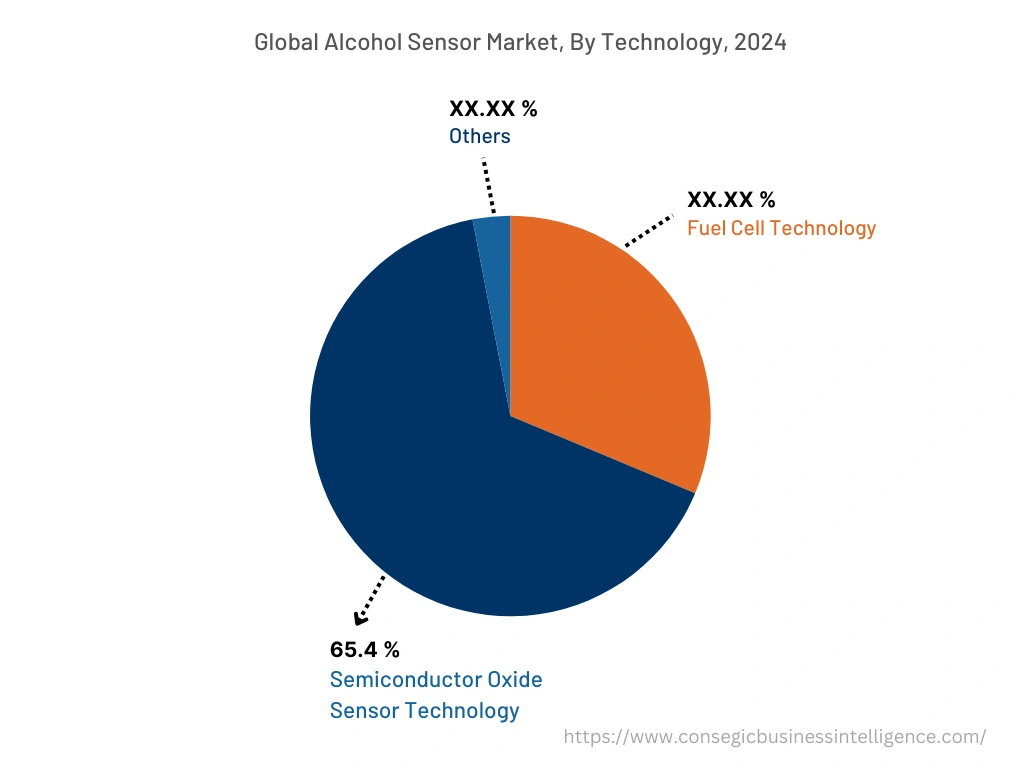
Based on the Sales Channel :
Based on the sales channel, the market is segregated into online and offline. In 2024, the online segment accounted for the highest alcohol sensor market share. Online sales channel offers a method of distribution in which the manufacturers sell products through the company websites or any other third-party e-commerce websites that are available on the internet. Online sales channels offer several benefits including an easy access to the products, quicker comparison of multiple products and prices, faster buying process, and higher flexibility. The aforementioned benefits of online sales channels are further increasing its utilization for the distribution of the sensors.
For instance, Lifeloc Technologies Inc. is among the few manufacturers that provide various types of alcohol breath analyzers for online purchase through the company website along with multiple e-commerce websites including eBay, Amazon, and others. Analysis of alcohol sensor market trends concludes that the increasing availability of the sensors in online sales channels, attributing to its above-mentioned benefits, is a key factor driving the market proliferation.
Offline segment is expected to witness fastest CAGR during the forecast period. Offline sales channel involves the distribution of the sensors from manufacturers to the end-users directly or indirectly through various offline distributors including specialty stores, supermarkets/hypermarkets, and others. The expansion of the offline segment is attributed to several factors including a strong customer base, higher credibility, and ease of customization as per the target market among others.
In March 2022, LuLu Group launched its new hypermarkets in Dubai City Mall, as a part of the company's expansion strategy. Additionally, the LuLu Group further launched two new hypermarkets in Shamkha Mall in Abu Dhabi, and Dubai Investment Park. Analysis of alcohol sensor market trends concludes that the rising development of hypermarkets is anticipated to drive the distribution of the sensors from offline stores, in turn fostering the market expansion during the forecast period.
Based on the Region :
The regional segment includes North America, Europe, Asia Pacific, Middle East and Africa, and Latin America.
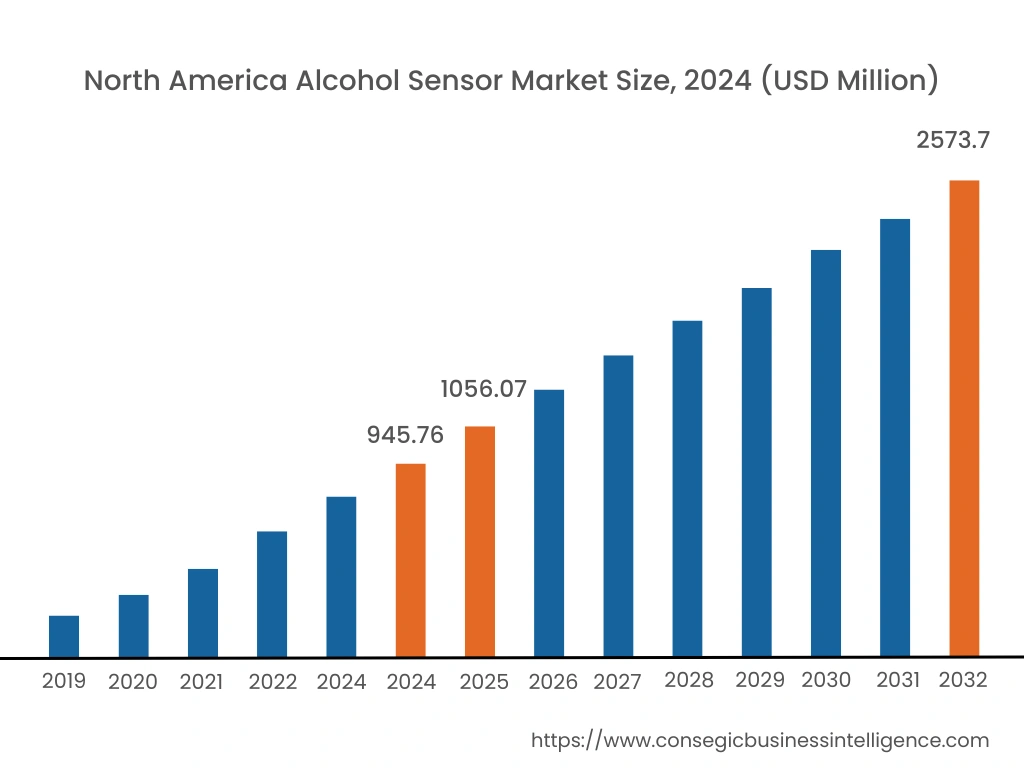
North America accounted for the largest revenue share of USD 945.76 Million in 2024 and is expected to reach USD 2,573.70 Million by 2032, registering a CAGR of 13.30% during the forecast period. In addition, in the region, the U.S. accounted for the maximum revenue share of 57.4% in the same year. The alcohol sensor market analysis concluded that the adoption of the sensors in the North American region is driven by multiple factors including the prevalence of strict drunk driving laws and rising government initiatives for installation of the sensors in modern automobiles for enhanced safety.
For instance, in 2021, the U.S. Government passed a new federal law that mandates the installation of alcohol impairment detection/monitoring systems in modern vehicles by 2026, with the aim of preventing impaired driving under alcohol influence. The above factors are further projected to drive the adoption of the sensors in modern automobiles, in turn driving the market proliferation in North America during the forecast period.
Asia-Pacific is expected to register fastest CAGR growth of 14.10% during the forecast period. Evaluation of market trends indicates that various factors including rapid increase of vehicles on roads, rising incidence of impaired driving accidents, and increasing the demand for impaired driving detection solutions are fostering the market expansion for the sensors in the Asia-Pacific region.
For instance, according to the Ministry of Road Transport and Highways of India, approximately 12,256 cases of drunken driving accidents occurred in India in 2019, depicting an increase of 2% in comparison to the previous year. Among the total cases of drunken driving accidents, 10,564 individuals were injured while 5,325 individuals were killed. The alcohol sensor market analysis concluded that the rising cases of impaired driving accidents is anticipated to drive the utilization of the sensors for identifying potential suspects that are driving under the influence of alcohol, thereby, proliferating the market growth in the Asia-Pacific region during the forecast period.
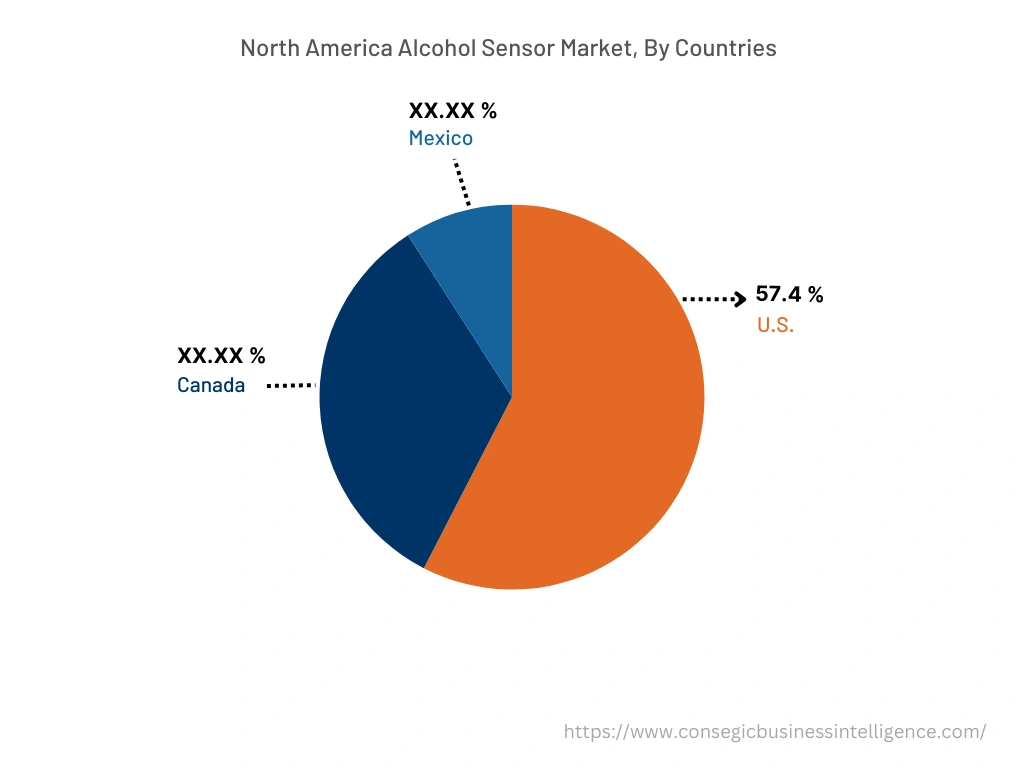
Top Key Players & Market Share Insights :
The alcohol sensor market is highly competitive with major players providing products to the national and international markets. The major companies operating in the alcohol sensor industry are adopting several strategies in research and development (R&D), product innovation, and sales channel launches to hold a strong position in alcohol sensor market. Key players in the alcohol sensor market include-
- Abbott
- Honeywell International Inc.
- Lifeloc Technologies Inc.
- CMI Inc.
- AK GlobalTech Corp.
- Asahi Kasei Corporation
- AlcoPro
- Alcohol Countermeasure Systems Corp.
- Dragerwerk AG & Co. KGaA.
- Intoximeters
Recent Industry Developments :
- In December 2022, Asahi Kasei Corporation announced its plan to introduce its innovations associated with new concept vehicle to shape future mobility. The innovations include the integration of Senseair alcohol sensor that is capable of detecting driver impairment in real-time and seamlessly integrating into vehicles.
Key Questions Answered in the Report
What is alcohol sensor? +
Alcohol sensors refer to devices that are designed for analysing samples of breath for measuring the concentration of ethanol in a person's system, which are further interpreted to estimate recent alcohol consumption or current impairment.
What specific segmentation details are covered in the alcohol sensor report, and how is the dominating segment impacting the market growth? +
For instance, by technology segment has witnessed semiconductor oxide sensor technology as the dominating segment in the year 2024, owing to its range of benefits including ease of fabrication, low cost, and simplicity of use.
What specific segmentation details are covered in the alcohol sensor market report, and how is the fastest segment anticipated to impact the market growth? +
For instance, by sales channel segment has witnessed offline channel as the fastest-growing segment during the forecast period due to its several benefits including a strong customer base, higher credibility, and ease of customization as per the target market.
Which region/country is anticipated to witness the highest CAGR during the forecast period, 2025-2032? +
Asia-Pacific is anticipated to register fastest CAGR growth during the forecast period due to rapid increase of vehicles on roads, rising incidence of impaired driving accidents, and increasing need for impaired driving detection solutions in the region.
